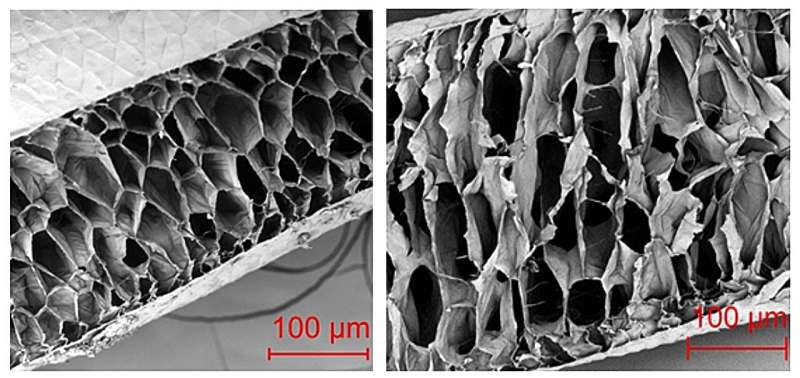
Air pockets inside pronghorn antelope hairs are smaller in summer (left) than in winter (right). Credit: Taylor Millett
Unique adaptations allow wild animals to survive temperature extremes that would quickly kill an unprotected human. For example, certain animals can withstand bitterly cold weather, thanks to the insulating properties of the hollow hairs that make up their coats.
Little has been known about these hairs, but now researchers have discovered that their inner structure changes with the seasons. The researchers will present their results today (March 17) at the spring meeting of the American Chemical Society (ACS).
“With some animals, the coat looks different in summer and winter,” says Taylor Millett, who is carrying out the research. A snowshoe hare turns white in winter and brown in summer, for instance. “But in the animals we’re studying, we’ve found that it’s not just the outer coloring of the hair that’s changing. The inner microscopic details are also changing to allow these animals to continue surviving in their environment.”
Millett, an undergraduate student in the mechanical engineering program at Utah Tech University, is being mentored by Wendy Schatzberg, an associate chemistry professor, and Samuel Tobler, a physics professor. Cristina De La Vieja Medina is another undergraduate working on the project.
Schatzberg and Tobler teach undergraduate students to use a scanning electron microscope (SEM), which bombards a sample with electrons to produce an image that clearly reveals microscopic details.
“Once the students learn how to use the SEM to investigate small particles, we give them the freedom to study other samples that interest them,” Schatzberg says. “Taylor decided to pick animal hair. I never was particularly interested in animal hair until she brought it to our attention, but it’s fascinating.”
Millett, who describes herself as outdoorsy, had heard that the hair of pronghorn antelope is hollow, but nobody knew much more about it than that. “So I decided to cut it open and use the SEM to see what was going on,” she recalls. For context, the dimensions of a pronghorn antelope’s hair range from 5 to 15 centimeters (less than 6 inches) in length, depending on its location on the animal. The average diameter of the antelope hair is 440 micrometers.
Credit: American Chemical Society
She then asked her mentors if she could do additional studies. She chose big game animals, because previous research at other institutions had focused on domesticated animals such as sheep or llamas. “Nobody had branched out to wild animals because it’s harder to get their hair,” Millett says.
In addition to pronghorn antelope, she selected mule deer and Rocky Mountain elk—prey animals that can be found close to campus. She obtained winter and summer animal hair samples from a local wildlife taxidermist and from the Utah Division of Wildlife Resources, which picks up animals that have been hit by cars.
Millett and De La Vieja Medina sliced the hairs open, gold plated them to improve the SEM image resolution, and then examined and measured the spongy interior structures. These structures, consisting of a random collection of tiny hollow cavities, or air pockets, resemble messy honeycombs.
The students found that in both summer and winter hairs, the air pockets near the perimeter of the hairs were much smaller than those in the core. In addition, winter hairs had larger air pockets than summer hairs in all three species. In mule deer, for example, winter air pockets had an average diameter of 26 micrometers, while summer air pockets averaged 13 micrometers in diameter.
The core of the summer hair was, therefore, much more densely packed than the winter hair. “This is very intriguing, because those pockets create an insulative barrier that keeps the animals warm in winter,” Millett says.
To determine whether these findings apply to other animals, including predator species such as bears, mountain lions and bobcats, Millett is contacting zoos around the world for hair samples. The researchers also want to assess how geographic location and climate affect the results, Schatzberg notes.
“Is it just our area that’s like this? And how much temperature difference between the seasons does it take? Sometimes up here we have a very large temperature difference between summer and winter,” she says. “So there are all these variables to examine.”
Millett is pondering how to apply the results. One potential application is synthetic insulation for houses and camping gear.
More information:
Hollow hair and how its structure helps big game animals thermoregulate. digitalcommons.usu.edu/spacegrant/2023/all2023/35/
Citation:
Animal hair structure changes from summer to winter to fend off freezing weather, researchers show (2024, March 17)
retrieved 17 March 2024
from https://phys.org/news/2024-03-animal-hair-summer-winter-fend.html
This document is subject to copyright. Apart from any fair dealing for the purpose of private study or research, no
part may be reproduced without the written permission. The content is provided for information purposes only.
>>> Read full article>>>
Copyright for syndicated content belongs to the linked Source : Phys.org – https://phys.org/news/2024-03-animal-hair-summer-winter-fend.html






























